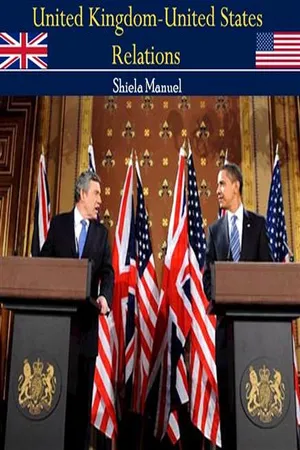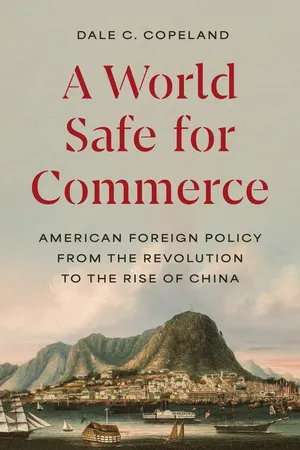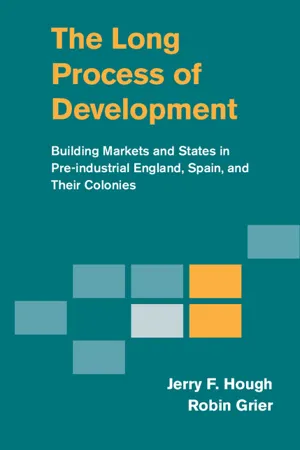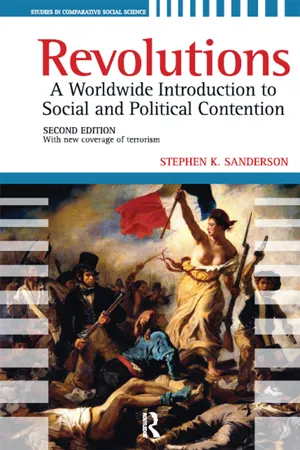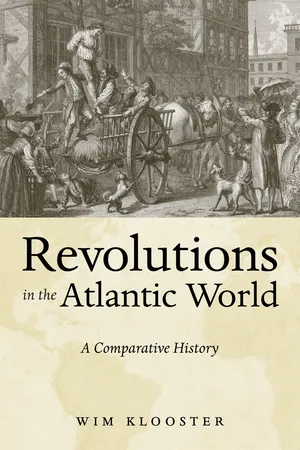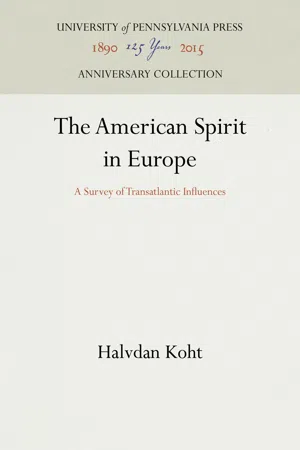History
Causes of the American Revolution
The causes of the American Revolution were rooted in issues such as taxation without representation, restrictions on trade, and the lack of self-governance. Tensions between the American colonies and the British government escalated due to these grievances, ultimately leading to the desire for independence and the outbreak of the Revolutionary War in 1775.
Written by Perlego with AI-assistance
Related key terms
1 of 5
9 Key excerpts on "Causes of the American Revolution"
- eBook - ePub
Lost History Of America
Information Not Found in Modern History Books
- Jody D Kimbrell(Author)
- 2020(Publication Date)
- URLink Print & Media, LLC(Publisher)
A new era was to commence in the West. The link, which for ages had bound England to America by the corroding influence of evil ministers, was to be broken; a new government was to be formed—one based on justice for all and in which the lowest voice as well as the highest could be heard. The Causes of the American Revolution, which ended in the firm establishment of our liberties, lay in the jealousy, tyranny, and oppression of the English government. The American colonists had freely given their blood and treasure for the maintenance of the power of the British crown. They had rushed to the battlefield, endured every hardship, and patiently submitted to the wrongs from the very hand they had strengthened. They had regarded England with reverence and affection and never dreamed of leaving the paternal roof, until the unholy chastisement of a parent’s hand alienated their love, expelled them from the threshold, and compelled them to seek shelter and security behind the bulwarks of righteous insurrection.In the early period of their colonial existence, Great Britain had troubled them but little about their internal policy, being satisfied with a monopoly of their trade and aid in the war with France. The colonies had increased in strength and population, and the war ended in a vast amount of territory for the English crown. This should have dictated a relaxation of their authority; instead they rose in their demands and increased the restraints. Heavy taxes were imposed to pay off England’s national debt, and it was forgotten the Americans were descended from the same forefathers as themselves and heirs to the same rights. Also bearing their share in the expense of the war, the colonies made no objections, but they did object to the system of taxation in which they had no right to be heard—something current American government officials should pay heed to.In 1765, Lord George Grenville, after giving notice to the American agents in London, introduced into parliament a long-cherished scheme for the purpose of raising revenue from the American colonies by means of a stamp duty. Petitions opposing the tax poured in from the Americans, and at first it met with opposition in the House of Commons. The following text took place in the halls of Parliament as those who chose to oppress America argued with those who wanted equality for the colonies.5 - No longer available |Learn more
- (Author)
- 2014(Publication Date)
- Orange Apple(Publisher)
The American shift to liberal republicanism, and the gradually increasing democracy, caused an upheaval of traditional social hierarchy and gave birth to the ethic that has formed a core of political values in the United States. ________________________ WORLD TECHNOLOGIES ________________________ Origins Before the Revolution: The Thirteen Colonies are in pink The American Revolution was predicated by a number of ideas and events that, combined, led to a political and social separation of colonial possessions from the home nation and a coalescing of those former individual colonies into an independent nation. Summary The American revolutionary era began in 1763, after a series of victories by British forces at the conclusion of the French and Indian War ended the French military threat to British North American colonies. Adopting the policy that the colonies should pay an increased proportion of the costs associated with keeping them in the Empire, Britain imposed a series of direct taxes followed by other laws intended to demonstrate British authority, all of which proved extremely unpopular in America. Because the colonies lacked elected representation in the governing British Parliament, many colonists considered the laws to be illegitimate and a violation of their rights as Englishmen. In 1772, groups of colonists began to create Committees of Correspondence , which would lead to their own Provincial Congresses in most of the colonies. In the course of two years, the Provincial Congresses or their equivalents rejected the Parliament and effectively replaced the British ruling apparatus in the former colonies, culminating in 1774 with the coordinating First Continental Congress. In response to protests in Boston over Parliament's attempts to assert authority, the British sent combat troops, dissolved local governments, and imposed direct rule by Royal officials. Consequently, the Colonies mobilized their militias, and fighting broke out in 1775. - eBook - PDF
A World Safe for Commerce
American Foreign Policy from the Revolution to the Rise of China
- Dale C. Copeland(Author)
- 2024(Publication Date)
- Princeton University Press(Publisher)
American scholars of course know that the war was much more than a fight over “taxation without representation.” But they remain divided on its ultimate causes. There are two main camps in the historical literature. The domestic politics camp focuses on the internal conflicts between regional fac- tions and between classes caused by the rise of commercial capitalism in the eighteenth century. Scholars within this camp, while diverse in their specific explanations, agree that elites across the colonies were driven by their own personal and local interests to expand those sectors of commerce and eco- nomic development in which they were most directly involved. Once the Brit- ish began seeking greater economic and political control over these sectors, they put aside their differences and their worries about emboldening the lower classes to unite in opposition to the British challenge.3 The second main camp emphasizes the role of ideology and shared values. The seminal work of Bernard Bailyn and Gordon Wood in the 1960s led many scholars to argue that the internalized ideas and ideals of liberty and freedom were indeed primary forces uniting the colonists to fight. The issue of taxation without consent was only one part of a much larger American concern for the colonists’ sense of their long-term way of life.4 Increasing British efforts from 1761 to 1775 to arrest Americans and seize their goods without specific war- rants, to limit the ability of colonial governments to issue paper money, to control the payment of governors and judges from London, to place British standing armies in their cities and not just on the frontier, and to quarter those troops at colonial expense were affronts to American conceptions of their tra- ditional liberties, protected, as they had presumed, by British law and norms. For this latter perspective, the war was not a conflict driven by the material interests of rising elites seeking more wealth and power at home. - eBook - PDF
The Long Process of Development
Building Markets and States in Pre-industrial England, Spain and their Colonies
- Jerry F. Hough, Robin Grier(Authors)
- 2014(Publication Date)
- Cambridge University Press(Publisher)
305 9 The Collective Action Problems of the Formation of the United States Revolutionaries naturally claim they represent the people against the repressors. They treat their revolution as coming from below and describe their constitutions as social contracts that express the public will. The text- book analyses of the American Revolution and the Constitutional Convention are typical. More sophisticated scholarly analysis normally fol- lows a different path. Societies undergo a variety of economic, technologi- cal, structural, and social changes, and these inevitably create pressure for political change as well. Such pressure eventually has an impact. Normally, political change comes through evolution – or, perhaps, through some type of military coup that is not accompanied by mass rev- olutionary activity. Unfortunately, when revolution does occur, scholars often do not distinguish between the causes of the revolution and the pres- sures for evolutionary change. Scholarly analysis of the American Revolution often shows this confu- sion of evolution and revolution. In Chapters 4, 6, and 7, we pointed to a number of basic changes that were taking place both in the colonies and in London around 1750. The population and territory of the colonies were becoming too large to be ruled through the old city-states. The colonial economies were becoming so complex and interconnected that some kind of coordinating government mechanism was needed. London had press- ing financial needs and was finally acquiring the ability to collect taxes in the colonies. Major political changes had to take place, but they did not have to take the form of the American Revolution, the War of Independence, and the Constitutional Convention – let alone any successful revolution, War of Independence, or stable political system afterward. Home rule within the empire or the formation of two relatively loose independent federations seemed far more likely. - eBook - ePub
Thomas Paine
Social and Political Thought
- Gregory Claeys(Author)
- 2020(Publication Date)
- Routledge(Publisher)
2‘The cause of all mankind’: Paine and the American revolution
Colonial radicalism, 1765–76
Common Sense exploded amidst an already volatile debate about colonial rights, imperial arbitrariness, and the possibility of resistance to British rule. American resentment had been instigated primarily by the passage of stamp duties on legal and other documents in 1765, which brought rioting and boycotts of British goods. In the late 1760s protest escalated in reaction to attempts to curtail the powers of colonial assemblies and to increase colonial revenues. The Wilkes case, as we have seen, fuelled unrest. British policy towards Ireland and India also seemed to some to betray the designs of ministerial tyranny. The failure of petitioning increased disappointments and eroded affections. More widely discussed as early as 1770–1 was armed resistance, and the view that colonial government was dissolving and might better be replaced by native rule. Independence was broached, though not widely supported, by 1772, the Dutch model being occasionally suggested. By 1774 the monarch, but a few years earlier the focus of hopes for respite from ministerial intrigue, had himself become a potent symbol of despotism. At Lexington and Concord in mid-1775 revolt finally became war.1Until 1776, however, the colonists’ unease produced little support for independence or strong opposition to monarchy among most colonists. As Gordon Wood has emphasized, most Americans believed the mixed British constitution to be the best possible and happily subscribed to the loyalism of John Dickinson’s popular Letters from a Farmer in Pennsylvania (1768). In this sense the majority were still British and did not yet identify, as Pauline Maier has stressed, with a self-consciously American collective entity. Paine himself claimed in early 1775 that ‘equality of liberty is the glory of every Briton. He does not forfeit it by crossing the ocean … A Briton or American ceases to be a British subject when he ceases to be governed by rulers chosen or approved of by himself. This is the essence of liberty and of the British constitution.’2 - eBook - ePub
Revolutions
A Worldwide Introduction to Political and Social Change
- Stephen K. Sanderson(Author)
- 2015(Publication Date)
- Routledge(Publisher)
Chapter Four The Causes of Revolutions: I F OR THE MOST PART, it is only in recent decades that scholars have undertaken to formulate general theories of revolution and other forms of major sociopolitical conflict. Earlier, historians and social scientists paid attention to revolutions, but they were more interested in detailed descriptions of their course than in why they occurred. Jack Goldstone (1982) has referred to this approach as the “natural history of revolutions.” This chapter will explore the natural history approach and look at the three major theoretical approaches to revolutions that have been developed: social-psychological theories, Marxian theories, and so-called state-centered theories - Available until 23 Dec |Learn more
Revolutions in the Atlantic World
A Comparative History
- Wim Klooster(Author)
- 2009(Publication Date)
- NYU Press(Publisher)
6The Revolutions Compared Causes, Patterns, LegaciesSeismic waves traveled through the Atlantic world in the half-century after 1775, linking uprisings on either side of the Atlantic. Divergent as they were, each was a revolution in its own right. This chapter compares the revolutions by trying to establish the main similarities and differences. Their chief common features can be summarized as follows.1. The revolutions must be understood, first of all, in the context of international politics. The costs of the Seven Years’ War led to a dramatic increase of taxation in British North America, and, combined with the War of American Independence, induced the French king to call for a meeting of the Estates General. Both the Thirteen Colonies and France were thus brought to the brink of revolution. What paved the way for the Spanish American revolutions was not a war, but Napoleon’s imprisonment of the Spanish king. International politics not only created the conditions, it also helped the insurgents succeed or made the eventual victory a hard-fought one. French aid to the North American rebels was as much motivated by power politics as Britain’s decision to stay out of the Spanish American wars and the expedition of soldiers by Britain and Spain to revolutionary Saint-Domingue.2. The revolts were not foreordained. They could have been prevented, derailed, or postponed. What is missing from the standard accounts of revolutionary upheaval is the element of contingency. Overthrow of the old regime was not even necessarily the initial goal of the aggrieved. As Hannah Arendt has reminded us, it “was only in the course of the eighteenth-century revolutions that men began to be aware that a new beginning could be a political phenomenon, that it could be the result of what men had done and what they could consciously set out to do.”1 The revolutions did not get a chance unless imperial stability was lost. Political scientists have argued for three key conditions for state stability: (a) rulers that are widely perceived as both effective and just; (b) elites that are unified and loyal to the regime; and (c) a population that is guaranteed a customary living standard. When these conditions of stability are simultaneously lost, a revolutionary situation is in the making.2 - eBook - PDF
The American Spirit in Europe
A Survey of Transatlantic Influences
- Halvdan Koht(Author)
- 2017(Publication Date)
II T H E A M E R I C A N R E V O L U T I O N A S A E U R O P E A N R E V O L U T I O N DIRECTLY and indirectly, by its immediate as by its subsequent effects, the American Revolution involved such changes in the conditions of Europe as virtually to amount to another revolution. The very external events were far-reaching in their conse-quences. The war of independence of the English colonies be-came a European war. In the course of the eighteenth century England had grown up to be the largest sea power of the world, and it used its supremacy in such a way as to rouse the anger and hostility of all other seafaring nations. The rebellion of the col-onies meant a breaking away of that part of the British Empire which possessed a considerable part of its marine, and all of Eu-rope seized upon the opportunity of weakening the British supe-riority. Some powers—France, Spain, Holland—joined the war against Great Britain. Well-nigh all the other powers of Europe united into the Armed Neutrality in order to safeguard the free-dom of the seas. Confronted with such formidable opposition, Great Britain chose to lay down her arms and recognize the inde-pendence of the colonies. On that occasion Edmund Burke said: A great revolution has happened—a revolution made, not by chopping and changing of power in any of the existing states, but by the appearance of a new state, of a new species, in a new part of the globe. It has made as great a change in all the relations, and balances, and gravitations of power, as the appearance of a new planet would in the system of the solar world. England still remained the largest sea power, and in another war, some few years later, was able to assert its supremacy more completely than at any time before. But it had been compelled to acknowledge the existence and the freedom of a new rival on the seas, the United States of America. There are no accurate statistics as to the size of the merchant 7 - eBook - PDF
Paths to a New Europe
From Premodern to Postmodern Times
- Paul Dukes(Author)
- 2017(Publication Date)
- Bloomsbury Academic(Publisher)
We must not forget it as we turn to consider the governments of Britain and France, and their opponents. THE CRITICS: THE AMERICAN REVOLUTION As a result of the Seven Years War (especially by its other name, of the French and Indian War), the British Empire asserted its supremacy over 103 ENLIGHTENED GOVERNMENTS, THEIR CONFLICTS AND THEIR CRITICS, 1763–1789 its chief rival in 1763. But success had bred almost as many problems as would have arisen from failure: what to do with the mainland colonies across the Atlantic now that the way west across the North American continent lay open for 2 million or more British subjects? Governor Bernard of Massachusetts sent the message back to the government in London that now was ‘the proper and critical time to reform the American governments upon a general, constitutional, firm and durable plan; and if it is not done now, it will probably grow every day more difficult, till at last it becomes impracticable’. 5 However, such messages took several weeks to cross the ocean, and the time lag accompanied, perhaps intensified, mutual difficulties of comprehen-sion. Not surprisingly, none of the leading British statesmen of the time ever made the long and dangerous crossing to the American colonies. Most of them found it difficult to understand why such remote societies were not continually consumed with gratitude for their membership of the British Empire. As for the Americans themselves, although a considerable number of them had visited the home country, their sense of it was often distorted. That is, they could not easily distinguish the Britain that they actually saw from the one in which they believed: distance tended to lend enchantment to their view of the British constitution, the wide gap in miles helping to shorten the passage of years. Consequently, for the colonists, the Bloodless and Glorious Revolution of 1688 retained a vitality that it had largely lost among its more immediate beneficiaries.
Index pages curate the most relevant extracts from our library of academic textbooks. They’ve been created using an in-house natural language model (NLM), each adding context and meaning to key research topics.

